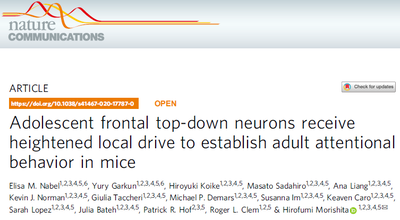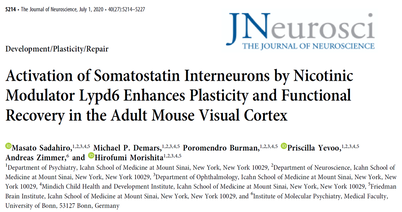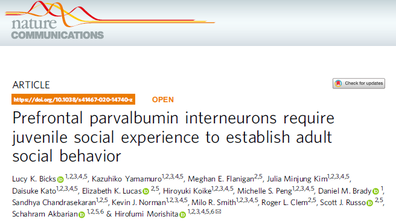Research
Cortical Mechanisms of Perceptual, Cognitive & Social Development
How much of our behavior and its disorders are determined by our genes and by our environment? This nature-nurture debate has continued for centuries by both philosophers and scientists. We now know our behavior reflects neural circuits sculpted by experience during “critical periods” in postnatal life. Such heightened plasticity declines into adulthood, often limiting recovery of function. On the other hand, the adult brain needs stability. Failed stabilization can disrupt circuit computations by allowing modification by undesirable information, which may lead to mental disorders. How does the brain solve this stability-plasticity dilemma? The goal of our lab is to identify the mechanisms of developmental critical periods to establish (1) perception, (2) cognition and (3) social behavior relevant to neuro-developmental and psychiatric disorders. Our strategy is to use visual system, a premier model of critical period for cortical plasticity, to discover molecular/ circuit mechanisms, and then apply these mechanisms as unique tools to dissect more complicated critical periods for cognitive behaviors such as attention and social cognition. We are an active member of Center for Neurotechnology and Behavior and Center for Affective Neuroscience at Mount Sinai.
Please visit https://www.morishita-lab.com/ for most updated information.
Experience-dependent Perceptual Development
Experience-dependent cortical plasticity is heightened during developmental critical periods but declines into adulthood, posing a major challenge to recovery of function following injury or disease later in life. Our research aims to identify the mechanisms of experience-dependent cortical plasticity. Using visual system, a premier model of critical period, we take an integrated approach, combining molecular, anatomical, imaging, electrophysiological methodologies (e.g. in vivo viral gene transfer, optogenetics, chemogenetics, and two-photon time lapse imaging). We also take translational bioinformatics approach to identify pro-plasticity drugs and anti-plastic perturbations. Our study would have direct implications for Amblyopia, a condition with limited adult-applicable treatment affecting 2–5% of the human population, but also for brain injury repair, sensory recovery, and the treatment of neurodevelopmental disorders.
Prefrontal Cortex-dependent Cognitive & Social Development
Mechanisms driving critical period circuit development are well described in sensory cortex—but poorly characterized for prefrontal cortex dependent cognitive behaviors. Impaired prefrontal cortical connectivity is increasingly identified in a host of several neuropsychiatric disorders that coincides with this protracted developmental period. A second major goal of our research is to examine to what extent a mechanism regulating the critical period for visual cortex development also modulates maturation of prefrontal cortex-dependent cognitive functions such as attentional behavior, and social cognition. We aim to identify the developmental regulatory mechanism of cognitive function from the molecular, circuit to the behavioral level. Identified circuit-associated mechanisms would promote translation of our basic research findings to clinical research to improve diagnosis, prevention and treatment of neuro-developmental disorders.
Contact Us
Hirofumi Morishita M.D. Ph.D
Associate Professor
Department of Psychiatry, Neuroscience, & Ophthalmology
Mindich Child Health & Development Institute
Friedman Brain Institute
Icahn School of Medicine at Mount Sinai
Postdoctoral Fellow/Graduate Student Positions Available
1) Circuit Mechanisms of Cognitive Development: The goal of this position is to identify novel prefrontal circuit mechanisms of cognitive control maturation. Potential project will combine in vivo optogenetics, pharmacogenetics, fiber photometry, and in vivo awake recordings in behaving mice.
Qualifications: PhD in neuroscience or relevant experience required. Experience with rodent in vivo analysis (e.g. stereotaxic surgery, behavior experiments, optogenetics), slice patch-clamp recording, programing is a plus.
2) Molecular Mechanisms of Social Circuit Development: The goal of this position is to identify novel molecular and genomic mechanisms of prefrontal circuit maturation in control of social behavior. Potential project will combine transcirptome, epigenomic approach, in vivo viral manipulation, fiber photometry in behaving mice.
Qualifications: PhD in neuroscience or relevant experience required. Experience with molecular biology, transcriptome data analysis, rodent in vivo analysis (e.g. stereotaxic surgery, behavior experiments), programming is a plus.
Application and required documents:
1) Cover letter, 2) Description of research experience, skills, & interests, 3) CV, 4) Names and contact information (email & tel) of 3 references with a brief description of your relationship to each reference. Please send the above information as a single pdf file to
hirofumi.morishita@mssm.edu
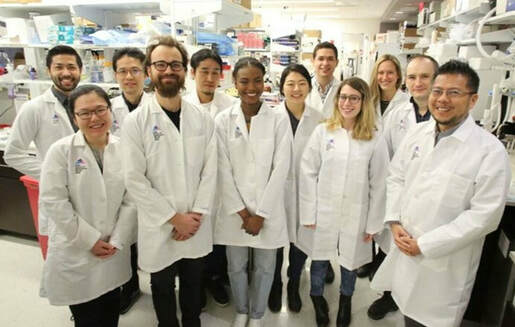
Biography
Hirofumi Morishita is an Associate Professor (tenured) of Psychiatry, Neuroscience and Ophthalmology at the Icahn School of Medicine at Mount Sinai. He is also a faculty member of interdisciplinary Mindich Child Health & Development Institute, and Friedman Brain Institute. His research focuses on understanding the mechanisms of developmental critical periods for cortical maturation to establish perception and cognition relevant to neurodevelopmental and psychiatric disorders. His laboratory takes an integrated approach, combining molecular, anatomical, imaging, electrophysiological, and behavior methodologies using mouse models. His research revealed key molecular and circuit level mechanisms of cortical maturation supporting perception (Journal of Neuroscience 2020, 2016, 2015, Science 2010), cognition (Neuron 2021, Nature Communications 2020), and social behavior (Nature Neuroscience 2020, Nature Communications 2020). Hirofumi Morishita received his PhD from Osaka University after Psychiatry residency at National Center Hospital of Neurology and Psychiatry in Tokyo and medical school training at Kyushu University (MD). Before joining Mount Sinai, he was a postdoctoral research fellow at Takao Hensch lab, Children’s Hospital Boston, Harvard Medical School.
Awards & Honors
2021-: Full Membership, American College of Neuropsychopharmacology (ACNP)
2020: One Mind Bipolar Research Award
2020-: Regular Member, NIH study section Neuroscience of Basic Visual Processes (NBVP)
Funding (Active)
2020-2023: R01 EY031009, National Eye Institute
2019 – 2024: R01 MH119523, National Institute of Mental Health
2019 – 2024: R01 MH120265, National Institute of Mential Health
2015 – 2021 (NCE): R01 EY024918, National Eye Institute
2019 – 2021: SFARI pilot award
2021
Post-error recruitment of frontal sensory cortical projections promotes attention in mice.
Neuron February 19, 2021. DOI:https://doi.org/10.1016/j.neuron.2021.02.001
# Featured in NIH NEI research news, NeuroscienceNews, NewsWise, Medindia, Medical Press, Technology Networks,
Bioengineer.org, EurekAlert! , News Medical, Joiforme , MedLink Neurology, PharmaC.Top, HealthNewsDigest, GlobeHealthNews

Morishita H
A prefrontal social circuit vulnerable to juvenile social isolation
Neuropsychopharmacology 2021 (Hot topic) DOI : 10.1038/s41386-020-00821-6
2020
Campbell BC, Nabel EM, Murdock MH, Lao-Peregrin C, Tsoulfas P, Blackmore MG, Lee FS, Liston C, Morishita H, Petsko GA.
mGreenLantern: a bright monomeric fluorescent protein with rapid expression and cell filling properties for neuronal imaging.
Proc Natl Acad Sci U S A2020 Nov 18:202000942. doi: 10.1073/pnas.2000942117.
Yamamuro K, Bicks LK, Leventhal M, Im S, Kato D, Flanigan ME, Garkun Y, Norman KJ, Caro K, Sadahiro M, Kullander K, Akbarian S, Russo SJ, and Morishita H
A prefrontal–paraventricular thalamus circuit requires juvenile social experience to regulate adult sociability in mice.
Nature Neuroscience 31 Aug 2020. DOI : 10.1038/s41593-020-0695-6
# Research Highlight “Testing Time Alone” by Sian Lewis. Nature Reviews Neuroscience 2020
# Press release “Researchers Discover a Specific Brain Circuit Damaged by Social Isolation During Childhood”
# Featured in ScienceDaily, NewsWise, NeuroscienceNews, Home Health Choice, Technology Networks, MDNewsDaily,
Open Access Government, SciSeek, Health Units, Scientist Study, Small Tech News, Medical X Press, EurekAlert!, Slash Gear,
Big Think, Psychology Today
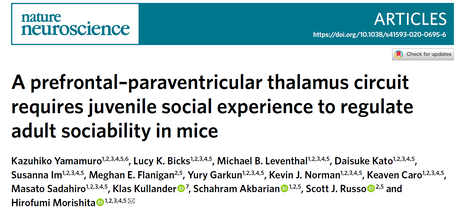
Nabel E, Garkun Y, Koike H, Sadahiro M, Liang A, Norman KJ, Taccheri G, Demars M, Im S, Caro K, Lopez S, Bateh J, Hof PR, Clem E, Morishita H
Adolescent frontal top-down neurons receive heightened local drive to establish adult attentional behavior in mice .
Nature Communications 7 Aug 2020. 11: 3983 (2020)
Open Access
Activation of somatostatin interneurons by nicotinic modulator Lypd6 enhances plasticity and functional recovery in the adult mouse visual cortex
Journal of Neuroscience 28 May 2020; DOI: https://doi.org/10.1523/JNEUROSCI.1373-19.2020
Systematic analysis of environmental chemicals that dysregulate critical period plasticity-related gene expression reveals common pathways that mimic immune response to pathogen.
Neural Plasticity 2020 May 5;2020:1673897. doi: 10.1155/2020/1673897. eCollection 2020.
Prefrontal parvalbumin interneurons require juvenile social experience to establish adult social behavior.
Nature Communications 2020 Feb 21, 11, 1003 (2020)
Open Access
# Social Isolation during adolescence drives long-term disruptions in social behavior
Featured article in Neuroscience News.Com
2019
Peña CJ, Smith M, Ramakrishnan A, Cates HM, Bagot RC, Kronman HG, Patel B, Chang AB, Purushothaman I, Dudley J, Morishita H, Shen L, Nestler EJ.
Early life stress alters transcriptomic patterning across reward circuitry in male and female mice.
Nature Communications 2019 Nov 8;10(1):5098. doi: 10.1038/s41467-019-13085-6. PubMed
Schrode N, Ho SM, Yamamuro K, Dobbyn A, Huckins L, Matos MR, Cheng E, Deans PJM, Flaherty E, Barretto N, Topol A, Alganem K, Abadali S, Gregory J, Hoelzli E, Phatnani H, Singh V, Girish D, Aronow B, Mccullumsmith R, Hoffman GE, Stahl EA, Morishita H, Sklar P, Brennand KJ
Synergistic effects of common schizophrenia risk variants.
Nature Genetics 2019 Sep 23. doi: 10.1038/s41588-019-0497-5. PubMed
Kana V, Desland FA, Casanova-Acebes M, Ayata P, Badimon A, Nabel E, Yamamuro K, Sneeboer M, Tan IL, Flanigan ME, Rose SA, Chang C, Leader A, Le Bourhis H, Sweet ES, Tung N, Wroblewska A, Lavin Y, See P, Baccarini A, Ginhoux F, Chitu V, Stanley ER, Russo SJ, Yue Z, Brown BD, Joyner AL, De Witte LD, Morishita H, Schaefer A, Merad M.
CSF-1 controls cerebellar microglia and is required for motor function and social interaction.
Journal of Experimental Medicine 2019 Jul 26. pii: jem.20182037. doi: 10.1084/jem.20182037. PubMed
Morishita, H*. Vinogradov, S*. (* corresponding authors)
Neuroplasticity and dysplasticity processes in Schizophrenia
Schizophrenia Research 2019 Mar 28. pii: S0920-9964(19)30090-8. PubMed
2018
Smith M, , Dudley J, Morishita H
Critical period plasticity-related transcriptional aberrations in schizophrenia and bipolar disorder.
Schizophrenia Research 2018 Nov 12th, pii: S0920-9964(18)30623-6. PubMed
Smith M, Yevoo P, Sadahiro M, Arora M, Dudley J, Morishita H
Integrative bioinformatics identifies postnatal lead (Pb) exposure disrupts developmental cortical plasticity.
Scientific Reports Nov 6;8(1):16388. doi: 10.1038/s41598-018-34592-4, 2018. PubMed
Smith M, Glicksberg B, Li L, Chen R, *Morishita H, *Dudley J (* corresponding authors)
Loss-of-function of neuroplasticity-related genes confers risk for human neurodevelopmental disorders.
Pac Symp Biocomput 2018 23:68-79. PubMed
2017
Jiang Y, Loh YE, Rajarajan P, Hirayama T, Liao W, Kassim BS, Javidfar B, Hartley BJ, Kleofas L, Park RB, Labonte B, Ho SM, Chandrasekaran S, Do C, Ramirez BR, Peter CJ, C W JT, Safaie BM, Morishita H, Roussos P, Nestler EJ, Schaefer A, Tycko B, Brennand KJ, Yagi T, Shen L, Akbarian S. The methyltransferase SETDB1 regulates a large neuron-specific topological chromatin domain. Nature Genetics 2017 Jul 3. doi: 10.1038/ng.3906. PubMed
Steullet, P., Cabungcal, J., Coyle, J., Didriksen, M., Gill, K., Grace, A., Hensch, T., LaMantia, A., Lindemann, L., Maynard, T., Meyer, U., Morishita, H., O’Donnell, P., Puhl, M., Cuenod, M., Do, KQ. Oxidative stress-driven parvalbumin interneuron impairment as a core mechanism in models of psychiatric disorders. Molecular Psychiatry 2017 Jul;22(7):936-943. PubMed
Morishita, H., Arora, M. Tooth-matrix biomarkers to reconstruct critical periods of brain plasticity. Trends in Neurosciences 2017. Jan 27; 40 (1):1-3. Pubmed # Video clip: Tooth Biomarkers Reconstruct Brain Plasticity
Smith, M., Burman, P., Sadahiro, M., Kidd, B., Dudley, J., Morishita, H. Integrative analysis of disease signatures shows inflammation disrupts juvenile experience-dependent cortical plasticity eNeuro 2017 Jan 18. 3 (6). Pubmed
2016
Sadahiro, M., Sajo, M., Morishita, H.
Nicotinic regulaiton of experience-dependent plasticity in visual cortex
Journal of Physiology-Paris 2016 Nov 10th, Review. Pubmed
Sajo, M., Ellis-Davies, G.C., Morishita, H.
Lynx1 limits dendritic spine turnover in the adult visual cortex
Journal of Neuroscience 2016 Sep7, 36(36):9472-9478 Pubmed
Mitchell, A.C., Javidfar, B., Bicks, L.K., Neve, R., Garbett, K., Lander, S.S., Mirnics, K., Morishita,H., Wood, M.A., Jiang, Y., Gaisler-Salomon, I., Akbarian, S.
Longitudinal Assessment of Neuronal 3D Genomes in Mouse Prefrontal Cortex.
Nature Communications 2016 Sep 6;7:12743. PubMed
Lucas, E.K., Jegarl, A.M., Morishita, H., Clem, R.L.
Multimodal and site-specific plasticity of amygdala parvalbumin interneurons after fear learning
Neuron 2016 2016 Aug 3;91(3):629-43. PubMed
Koike, H., Demars, M.P., Short, J.A., Nabel, E.M., Akbarian, S., Baxter, M.G., Morishita, H.
Chemogenetic Inactivation of Dorsal Anterior Cingulate Cortex Neurons Disrupts Attentional Behavior in Mouse.
Neuropsychopharmacology 2016. Mar, 41 (4) 1014-23, doi: 10.1038/npp.2015.229. PubMed
2015
Bicks, L., Koike, H., Akbarian, S., Morishita,H.
Prefrontal cortex and social cognition in mouse and man
Frontiers in Psychology. Front. Psychol. | doi: 10.3389/fpsyg.2015.01805. Review.PubMed
Bukhari, N., Burman, P., Hussein, A., Demars, M.P., Sadahiro, M., Brady, D., Tsirka, S.E., Russo, S.J., Morishita, H.
Unmasking proteolytic activity for adult visual cortex plasticity by the removal of Lynx1.
Journal of Neuroscience 2015. Sep 16;35(37):12693-702. PubMed
Morishita, H., Kundakovic, M., Bicks, L., Mitchell, A., Akbarian, S.
Interneuron Epigenomes duing the Critical Period of Cortical Plasticity: Implications for Schizophrenia.
Neurobiology of Learning and Memory.2015 Oct;124:104-10. Review.PubMed
Morishita, H., Cabungcal, J., Chen, Y., Do, KQ., Hensch, TK.
Prolonged period of cortical plasticity upon redox dysregulation in fast-spiking interneurons.
Biological Psychiatry Sep 15;78(6):396-402.PubMed
2014
Demars, MP., Morishita, H.
Cortical parvalbumin and somatostatin GABA neurons express distinct endogenous modulators of nicotinic acetylcholine receptors. Molecular Brain 2014 Oct 31;7(1):75. PubMed
2013
Nabel E, Morishita H.
Regulating Critical Period Plasticity: Insight from the Visual System to Fear Circuitry for Therapeutic Interventions.
Front. Psychiatry 2013 Nov 11: 4: 146. Review PubMed
Sajo, M., Morishita, H.
Critical Period Mechanisms: Implication for Neurodevelopmental and Psychiatric Disorders.
Brain and Nerve 2013; 65(10) 1159-66. Review PubMed
Cabungcal JH, Steullet P, Morishita H, Kraftsik R, Cuenod M, Hensch TK, Do KQ.
Perineuronal nets protect fast-spiking interneurons against oxidative stress.
Proc Natl Acad Sci U S A. 2013 May 13. 110 (22) 9130-5: PubMed
# Safety Net: Perineuronal Nets Protect Interneurons Linked to Schizophrenia
Research News in Schizophrenia Research Forum
# Damaged Protective ‘Net’ May Cause Malfunction in Brain Cells in Schizophrenia
Discoveries in Brain & Behavior Research Foundation
Morishita, H.
Molecular Strategies for Recovery from Amblyopia.
Ophthalmology 013; 55(1) 23-28. Review
2012
Morishita, H.
Cholinergic contribution on visual cortex plasticity.
Clinical Neuroscience 2012; 30(6) 649-651. Review
Morishita, H.
Molecularly targeted therapeutic strategies for Amblyopia
NeuroOphthalmol 2012; 29(4) 389-395. Review
2010-2006
Morishita, H., Miwa, JM., Heintz, N., Hensch, TK..
Lynx1, a cholinergic brake limits plasticity in adult visual cortex.
Science 2010 Nov 26; 330(6008):1238-40. view in: PubMed
# Perspective by Higley MJ, Strittmatter SM.
Science. 2010 Nov 26; 330(6008):1189-90.
# Editor’s Choice by Hines PJ. Science Signaling
2010 Nov 30
# Understanding the brain’s “Brake Pedal” in Neural
Plasticity. Scientific American. 2011 Feb 22.
# Removing an Endogenous Prototoxin Restores Vision.
Harvard MCB News. 2010 Dec 9.
# Alzheimer’s drugs for “lazy eye”?
Children’s Hospital Boston’s science and
clinical innovation blog. 2010 Dec 16.
# Supported by the James S. McDonnell Foundation
“Recovery from Amblyopia” network
Morishita, H., Hensch, TK.
Critical period revisited: impact on vision.
Current Opinion in Neurobiology. 2008 Feb; 18(1):101-7. Review. view in: PubMed
Morishita, H.*, Yagi, T.*. (*co-corresponding authors)
Protocadherin family: diversity, structure, and function.
Current Opinion in Cell Biology. 2007 Oct; 19(5):584-92. Review. view in: PubMed
Morishita, H.*, Umitsu, M.*, Murata, Y., Shibata, N., Udaka, K., Higuchi, Y., Akutsu, H., Yamaguchi T, Yagi, T., Ikegami, T.
Structure of the cadherin-related neuronal receptor/protocadherin-alpha first extracellular cadherin domain reveals diversity across cadherin families.
Journal of Biological Chemistry. 2006 Nov 3; 281(44):33650-63. view in: PubMed
# Evaluated by Faculty of 1000 Biology
2005-2001
Umitsu, M.*,Morishita, H.*, Murata, Y., Udaka, K., Akutsu, H., Yagi, T., Ikegami, T. (* equal first authors)
1H, 13C and 15N resonance assignments of the first cadherin domain of Cadherin related neuronal receptor/Protocadherin α.
Journal of Biomolecular NMR. 2005, Apr; 31(4):365-6. view in: PubMed
Morishita, H., Murata, Y., Esumi, S., Hamada, S., Yagi, T.
CNR/Pcdhα family in subplate neurons, and developing cortical connectivity.
Neuroreport. 2004 Dec 3; 15(17): 2595-2599. view in: PubMed
Morishita, H., Kawaguchi, M., Murata, Y., Seiwa, C., Hamada, S., Asou, H., Yagi, T.
Myelination triggers local loss of axonal CNR/Protocadherinα family expression.
European Journal of Neuroscience. 2004 Dec 2; 20(11): 2843-2847. view in PubMed
Murata, Y., Hamada, S., Morishita, H., Mutoh, T., Yagi, T.
Interaction with Protocadherin-g regulates the cell-surface expression of Protocadherin-α.
Journal of Biological Chemistry. 2004 Nov 19;279(47): 49508-49516. view in PubMed
Tada, M., Senzaki, K., Tai, Y., Morishita, H., Tanaka, Y., Murata, Y., Ishii, Y., Asakawa, S., Shimizu, N., Sugino, H., Yagi, T.
Genomic organization and transcripts of the zebrafish Protocadherin genes.
Gene. 2004 Oct 13; 340(2):197-211. view in PubMed
Morishita, H., Makishima, T., Kaneko, C., Lee, YS., Segil, N., Takahashi, K., Kuraoka, A., Nakagawa, T., Nabekura, J., Nakayama, K., Nakayama, KI.
Deafness due to degeneration of cochlear neurons in caspase-3-deficient mice.
Biochemical and Biophysical Research Communications. 2001 Jun 1; 284(1):142-9. view in PubMed
Team


Hirofumi Morishita MD PhD
Associate Professor

Yury Garkun PhD
Postdoctoral Fellow

Kohei Yoshitake PhD
Postdoctoral Fellow

Ting-Jiun Chen PhD
Postdoctoral Fellow

Lucy Bicks
PhD Student
(with Morishita and Akbarian Lab)

Kevin Norman
PhD Student

Michael Leventhal
PhD Student

Priscilla Maccario
Research Assistant
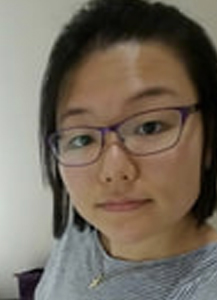
Susanna Im
Research Assistant

Leah Waltrip
Research Assistant

Ana Liang
Research Assistant

Meaghan Janis
Research Assistant
Contact Us
We accept rotation students from
Mount Sinai PhD, MD-PhD, MD, & MS programs
For postdoc position, please contact
hirofumi.morishita@mssm.edu
Mail Address:
One Gustave L. Levy Place Box1230
New York, NY 10029
Lab Location
1470 Madison Avenue
Hess Center 9-301 (lab), 9-113 (office)
New York, NY 10029


